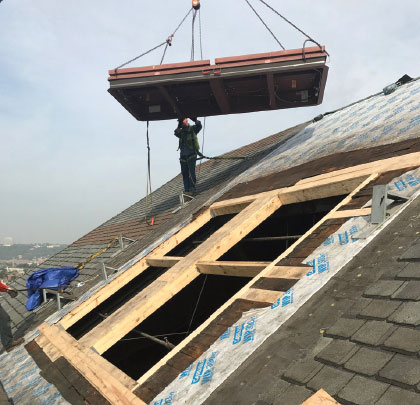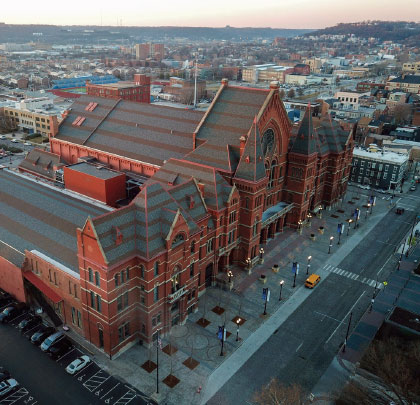With its unique history and commitment to cultural programs, Cincinnati Music Hall stands as one of the iconic buildings in The Queen City. Built in 1878, the Venetian Gothic structure designed by famous architect Samuel Hannaford has undergone multiple renovations, additions, and upgrades over time.
The recent 2-year, $143-million overhaul was perhaps Music Hall’s most extensive rebuilding project. The design included the addition of 31,549 additional square feet and required a complete shutdown of the facility for nearly 15 months. Its centerpiece, Springer Auditorium, was reconfigured and other improvements decreased seating capacity but increased comfort, added code-compliant accessibility for people with disabilities, and enhanced its exterior appearance.
Imbus Roofing of Wilder, Kentucky, installed a new roof on the building, overcoming several challenges in the process. Andrew Imbus, the project manager for Imbus Roofing, says the project required considerable planning. “Roof replacement was an important part of the project, for protecting the interior and for the overall look of the building. Since it’s an older building and with all the other work being performed, such as painting, masonry, and HVAC, we had to plan the work carefully.”
RESTORING A LANDMARK
Music Hall, which was recognized in January 1975 as a National Historic Landmark by the U.S. Department of the Interior, serves as the home of the Cincinnati Opera, Cincinnati Ballet, Cincinnati Pops Orchestra, and May Festival Chorus.
The facility hosted the 1880 Democratic National Convention and is also the home to the May Festival, whose roots in the city go back to the early 1800s. The May Festival Chorus was the first event held at the Music Hall, which was dedicated on May 14, the first day of the concert.
The facility also has its share of controversial history. Riots in 1884 began at a protest meeting at Music Hall, with protestors upset at what they believed to be a corrupt legal system. About 10,000 Cincinnati residents marched to the courthouse, and 56 people died in the violence. In addition, The Travel Channel included Music Hall as one of its Most Terrifying Places in America. Rumors have swirled for years about paranormal activity at Music Hall.
Hannaford, who also designed City Hall in Cincinnati, served as the architect for more than 300 buildings, and his residential designs appear throughout New England, the Midwest, and South in the United States.
TAKE IT FROM THE TOP
Before work began, visitors looking at Music Hall’s gable peaks detected damage to the finials. Thea Tjepkema, a board member of the Society for the Preservation of Music Hall (SPMH), zoomed in on historic photographs to find four unique designs for the finials. SPMH hired EverGreene Architectural Arts to prepare replacements, and FARO Technologies used high-tech 3D scans to measure the finials as close to 1/8 inch. EverGreene also used photographic research to design the missing metal cresting pinnacles on the roofline.
Imbus and his team took care of the larger-size roofing restoration. One of the primary tasks for Imbus was ensuring safety of workers and setting up scaffolding. “The steep slope of the roof was a big challenge,’’ Imbus says. “Getting the entire work area scaffolded and creating safe working conditions took time. Because there was so much going on, we had to open up the framing and get it watertight within a day.”
Imbus, whose business had installed the last roof atop Music Hall in 1988, searched to find replacement shingles that mirrored those of the past to preserve the historical integrity of the building. Working with PWWG Architects, Midwest Roofing Supply, and 3CDC, Imbus Roofing installed approximately 600 squares of CertainTeed’s Grand Manor shingles in Stonegate Gray and Brownstone.
The roof also required new double leaf smoke hatches, manufactured by The BILCO Company of New Haven, Connecticut. Imbus’ team installed seven DSH Automatic Smoke Vents. The vents, which measured 66 inches by 144 inches, are among the largest smoke hatches on the commercial market. The existing smoke vents were nearly 50 years old, Imbus says, and were larger than the BILCO vents that his company installed. “They allow for the same amount of ventilation as the previous vents, which is all based on fire codes; these were the safest solutions for this project,” says Imbus.
The smoke vents include a Thermolatch® II positive release mechanism that ensures reliable vent operation when a fire occurs. The vents automatically release upon the melting of a UL-listed 165F fusible link, and a curb-mounted fusible link allows the latch to be easily reset from the roof level. The vents are fully insulated and gasketed for weather tightness. The vents are hard-wired to the fire suppression system and open electronically if the sprinkler system activates. Corken Steel, the local distributor of the smoke vents, and BILCO rep Joe DeFrain of Welling, Inc., worked with Imbus to procure the vents.
COMPLIANT RENOVATIONS
Previous capacity at Music Hall reached 3,417, but the current configuration includes seating for 2,263 to 2,254, depending on the configuration for the event. Accessibility and sightlines were improved, and seats increased in width size from 19-21 to 20-23 inches. The distance between rows also increased, from 33-35 to 35-36 inches. A new stage lift system makes for flexible seating arrangements depending on the company performing at the auditorium.
In addition, the renovations made the building compliant with the Americans with Disabilities Act, with increased wheelchair accessible seating in prime locations, easier movement between floors, motorized wheelchair charging stations at some seat locations, and new elevators that permit access to every floor. The previous building was constructed before the ADA Act, most restrooms were inaccessible for physically-challenged patrons and wheelchair guests found it difficult to navigate between floors.
All events in Music Hall are now fully accessible, and improvements included assistive listening devices to enhance the sound quality of performances for hearing impaired guests. Special seating is also available.
The auditorium will also include a new stage lift system, and acousticians conducted extensive testing to make certain Music Hall’s natural sound more immersive and evenly distributed to every seat in the auditorium.

The roof required new double leaf smoke hatches, manufactured by The BILCO Company, which measured 66 inches by 144 inches—the largest smoke hatches on the commercial market.
For More Information:
For more information about Cincinnati’s Music Hall, visit www.cincinnatiarts.org/music-hall. For more information about Imbus Roofing, visit www.imbusroofing.com. To learn more about The BILCO Company smoke vents, visit www.bilco.com.
_________________________________________________________________________
Modern Contractor Solutions, June 2018
Did you enjoy this article?
Subscribe to the FREE Digital Edition of Modern Contractor Solutions magazine.



